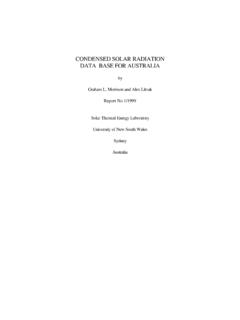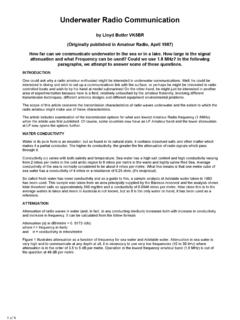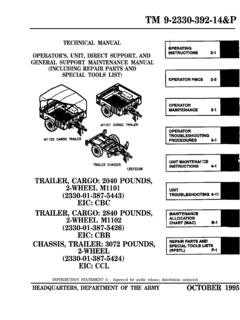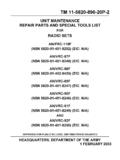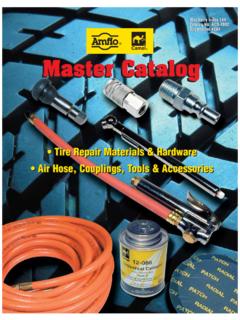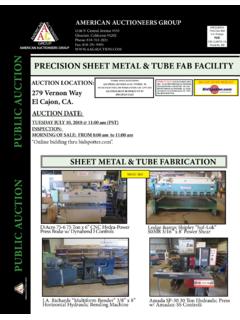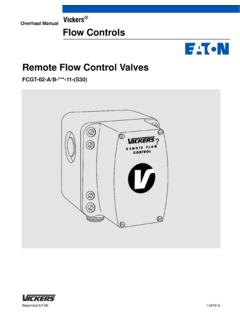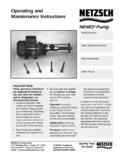Transcription of Meanwell User Manual - TPG Internet
1 1 Phone: (03) 98306288 MEAN WELL SPS user Manual 1. INPUT INPUT VOLTAGE Switching Power Supplies (SPS) are widely used all over the world. Many types of products are available for both alternating and direct current input. Before using any power supply, ensure that the output voltage and current is suitable for the intended load. Verify the correct input connections and any other conditions that might affect the power supply's operation. If an input voltage is applied which is different from the power supply's rating, the unit may be damaged. Also remember that if the input voltage wave is distorted, the power supply may not operate normally, even though the measured voltage is within the allowable range.
2 A Meanwell inverter can be used but it must be over-rated due to the inrush current at switch on. For all Mean Well Safety Approved Models refer to the label on the power supply for the input voltage range. Fig. 1 INPUT CURRENT Standard switching power supplies directly rectify the input Alternating Current (AC). Most standard units are capacitor-input-type, rectifying systems in which rectified current flows through the smoothing or filtering capacitor. Therefore, the input current is determined by the output power, input voltage, power factor, and efficiency. Fig. 2 The power factor of the typical switching power supply is between and , for Active PFC (Power Factor Correction) units it's or more at full load. Active PFC also provides significantly reduced harmonic currents to meet EMI requirements.
3 INRUSH CURRENT When power is applied, a large current flows to charge the input smoothing or filter capacitor. This current is called the "inrush current". The value of the inrush current varies according to the power-on timing and the presence or absence of the inrush current protection devices. The inrush current is many times larger than the normal input current. The more switching power supplies used in the same system, the larger the inrush current. Please ensure that fuses, switches, and other parts connected to the input supply side are appropriately selected. Also, when powering switching power supplies from a DC to AC inverter you will need to allow for this inrush current and make allowance for the switch-on sequence of multiple supplies. 2 Phone: (03) 98306288 Fig.
4 3 If the switching power supply fuse is blown, do not replace the fuse and operate the unit before rectifying the problem that caused it to fail otherwise further damage may occur to the power supply! Always replace the fuse with the same rated type. Always remove power to the unit before attempting to replace the fuse. WARNING: High voltage inside - do not open the case. Always return to an authorized agent for any repair. 2. OUTPUT MAXIMUM OUTPUT POWER Maximum power output (Pout) is defined as: Pout = Vout x Iout Where Vout is the output voltage and Iout is the output current. Most power supplies allow Vout to be adjusted. However, Pout must remain constant. Therefore, if Vout is increased, the maximum Iout must be decreased. The RS-50-5 power supply has an output voltage of 5 volts and an output current of 10 amps.
5 The maximum power output is 50 watts. The adjustable voltage range is volts to volts. If the output voltage is adjusted to volts, the maximum output current can be calculated by: Iout = Pout / Vout Iout = 50 watts / volts = amps. The output voltage can also be adjusted lower than 5 volts. However, due to the design of the output circuit, exceeding the 10 amp maximum output is not recommended as over current protection may activate. Some multiple output power supplies have a Current Range that exceeds the Output Rated Current. The table below has some specifications for the RD-65A (dual output) power supply. Channel Output Voltage Output Rated Current Output Current Range 1 5V 6A ~ 8A 2 12V 3A ~ 4A Ch. 1 can output 8 amps but the total power output cannot exceed 66 watts.
6 For example, if Ch. 1 was operated at a amp output, the Ch. 2 output current would have to be reduced to remain within the 66 watt limit. The total output power for Ch. 1 would be: (5 volts) x ( amps) = watts. This would allow watts for Ch. 2. The total current available for Ch. 2 is: ( watts) / (12 volts) = amps. OVERCURRENT PROTECTION (OCP) / OVERLOAD PROTECTION (OLP) Mean Well Power Supplies are equipped with a protection circuit that will automatically operate when the output current and/or output power exceeds a minimum 105-110% of the rating. Types of Protection: a. Foldback Current Limiting: The Foldback Current Limiting circuit is designed to linearly decrease both the voltage and current to a level that will prevent the power supply from being damaged during overcurrent/overload conditions.
7 Foldback Current Limiting is most often used in linear power supplies but it is sometimes used in switching power supplies. See curve "a" in Fig. 4. 3 Phone: (03) 98306288 b. Constant Current Limiting: Constant Current Limiting allows the output current to remain stable, but reduces the output voltage to a level that permits the safe operation of the power supply. Constant Current Limiting is preferred when charging batteries and when driving devices such as motors, incandescent lamps and highly capacitive loads which have a high initial current. See curve "b" in Fig. 4. c. Constant Power Limiting: Constant Power Limiting linearly reduces the output voltage and simultaneously allows the output current to increase.
8 Constant power limiting is most often used in multiple voltage output switching power supplies. See curve "c" in Fig. 4. d. Hiccup Current Limiting: When overloaded, the output voltage and current will be shut down for a short period of time and then automatically attempt to periodically recover again (hi-cup) until the fault condition is removed. In rare cases ( S-150) the output voltage is shut down permanently, reducing the output voltage and current to zero. A Manual recovery is then necessary. Some power supplies may have constant current down to 75% or 50% of the rated output voltage below this the hiccup mode operates. In other cases a power supply will operate in constant current mode and then shutdown after a time delay of 3 to 5 seconds. Fig.
9 4 Recovery Circuits a. Automatic Recovery Automatic Recovery senses the removal of the fault condition and returns the power supply to normal operation. b. Manual Recovery Before proceeding with Manual Recovery, make sure that the fault condition is removed. Manual Recovery requires cycling the input power off and on. A ten to thirty second wait is necessary before turning on again. Overcurrent /Overload Precautions Protection and Recovery circuits are designed to prevent damage to the power supply during an Overcurrent or Overload condition. However, leaving a power supply overloaded (or shorted) for extensive periods of time is NOT recommended and may result in reduced life and/or damage to the power supply. OVER TEMPERATURE PROTECTION (OTP) Some power supplies have an excessive temperature shut down circuit.
10 When the power supply's operating temperature is too high, the protection circuit will shut down the output. Some common causes of excessive temperature are Overcurrent/Overload, high ambient temperature or restricted ventilation ( faulty cooling fan). Automatic or Manual recovery can occur once the cause of the over temperature condition is removed (high ambient temperature and/or high load). OVER VOLTAGE PROTECTION (OVP) When the output voltage exceeds the rated value by approximately 130%, the power supply will be protected by the following two possible methods to prevent damage to the components at the load terminals: a. Shutdown the output voltage. Reset the power supply by turning it OFF for several seconds and then back ON again. b. Hiccup mode.



